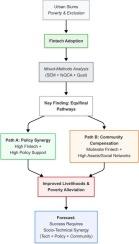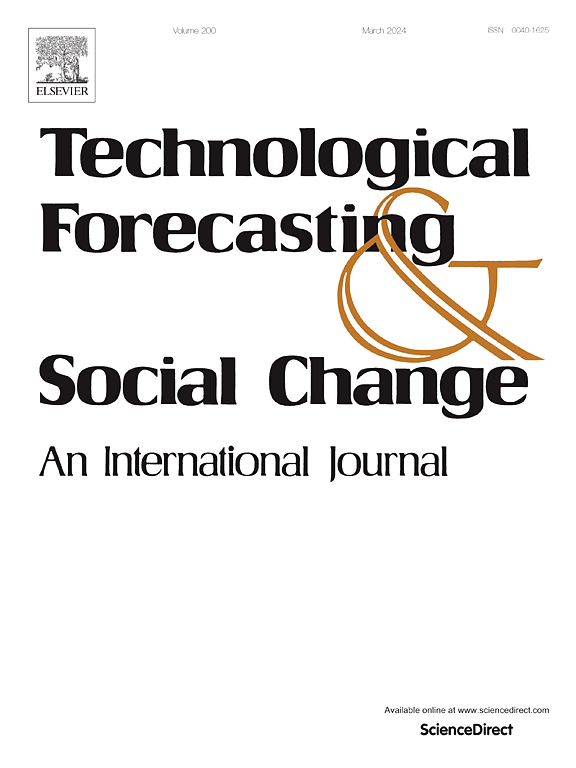预测包容性未来:金融科技、能力扩张和城市生计路径
IF 13.3
1区 管理学
Q1 BUSINESS
Technological Forecasting and Social Change
Pub Date : 2025-10-01
DOI:10.1016/j.techfore.2025.124369
引用次数: 0
摘要
预测金融科技在低收入环境中的扶贫机制的严格证据仍然很少。本研究结合Sen的能力方法和可持续生计框架,分析了金融科技对印度贫民窟生产性信贷使用、资产和能力的影响。混合方法设计(N = 600调查,40访谈)结合结构方程模型(SEM)和模糊集定性比较分析(fsQCA)。SEM证实,金融科技的采用强烈预测生产性信贷使用(β = 0.68, p < 0.001),促进资产(β = 0.72)和能力(β = 0.75),改善生计(β = 0.70);政策支持显著调节初始金融技术-信贷联系(β = 0.30, p = 0.002)。作为SEM净效应的补充,fsQCA揭示了改善生计的两种充分、等效的途径:(1)在强有力的政策支持下采用高水平的金融科技(一致性:0.87,覆盖率:0.42),显示出政策协同效应;(2)在强大的社交网络和先前资产的补偿下,适度使用金融科技(一致性:0.82,覆盖率:0.31),突出了社区补偿机制。定性数据阐明了信任、数字素养、指导和性别动态的关键作用,一项多群体分析定量证实了这一发现,表明女性在利用社交网络方面明显更有效,同时也揭示了数字排斥和潜在债务陷阱等风险。研究结果预测,成功的金融科技减贫部署需要协同的社会技术生态系统,将技术与扶持政策、社区结构和积极缓解负面外部性相结合,从而为包容性、可持续社会变革战略提供信息。本文章由计算机程序翻译,如有差异,请以英文原文为准。

Forecasting inclusive futures: Fintech, capability expansion, and livelihood pathways in urban in
Rigorous evidence forecasting fintech's poverty alleviation mechanisms in low-income settings remains scarce. Integrating Sen's Capability Approach and the Sustainable Livelihoods Framework, this study analyzes fintech's influence on productive credit use, assets, and capabilities in Indian slums. A mixed-methods design (N = 600 survey, 40 interviews) combines Structural Equation Modeling (SEM) and fuzzy-set Qualitative Comparative Analysis (fsQCA). SEM confirms fintech adoption strongly predicts productive credit use (β = 0.68, p < 0.001), fostering assets (β = 0.72) and capabilities (β = 0.75), improving livelihoods (β = 0.70); policy support significantly moderates (β = 0.30, p = 0.002) the initial fintech-credit link. Complementing SEM's net effects, fsQCA reveals two sufficient, equifinal pathways to improved livelihoods: (1) high fintech adoption with robust policy support (Consistency: 0.87, Coverage: 0.42), demonstrating policy synergy, and (2) moderate fintech usage compensated by strong social networks and prior assets (Consistency: 0.82, Coverage: 0.31), highlighting community compensation mechanisms. Qualitative data illuminate crucial roles of trust, digital literacy, mentorship, and gender dynamics, a finding quantitatively substantiated by a multi-group analysis revealing that women are significantly more effective at leveraging social networks, while revealing risks such as digital exclusion and potential debt traps. Findings forecast that successful fintech deployment for poverty reduction necessitates synergistic socio-technical ecosystems—combining technology with enabling policies, community structures, and proactive mitigation of negative externalities—thereby informing strategies for inclusive, sustainable social change.
求助全文
通过发布文献求助,成功后即可免费获取论文全文。
去求助
来源期刊
CiteScore
21.30
自引率
10.80%
发文量
813
期刊介绍:
Technological Forecasting and Social Change is a prominent platform for individuals engaged in the methodology and application of technological forecasting and future studies as planning tools, exploring the interconnectedness of social, environmental, and technological factors.
In addition to serving as a key forum for these discussions, we offer numerous benefits for authors, including complimentary PDFs, a generous copyright policy, exclusive discounts on Elsevier publications, and more.

 求助内容:
求助内容: 应助结果提醒方式:
应助结果提醒方式:


